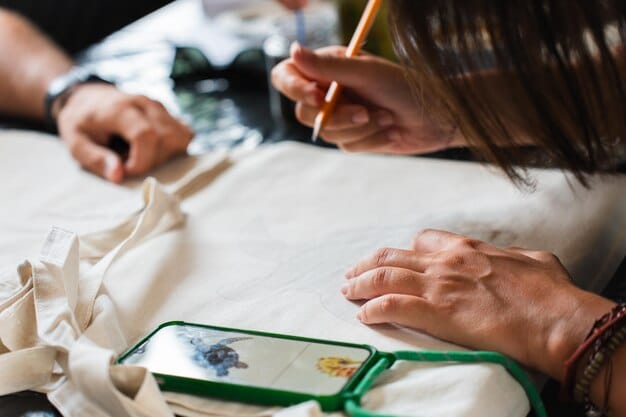Social Media’s Impact on Emerging US Designers: A Data-Driven Analysis

The impact of social media on emerging US designers is profound, offering unprecedented opportunities for exposure, brand building, and direct engagement with consumers, while also presenting challenges related to authenticity and market saturation.
The digital age has revolutionized numerous industries, and fashion is no exception. The impact of social media on emerging US designers: A data-driven analysis reveals how these platforms are reshaping the landscape for new talents.
The Rise of the Digital Runway
Social media has democratized the fashion industry, providing emerging designers with a level playing field to showcase their work. Unlike the traditional route of relying on established fashion houses and media outlets, designers can now directly connect with their target audience.
Direct-to-Consumer Engagement
Platforms like Instagram, TikTok, and Pinterest allow designers to bypass traditional gatekeepers and engage directly with consumers. This direct-to-consumer approach fosters a sense of community and allows designers to gather immediate feedback on their creations.
Building a Brand Identity
Social media provides a canvas for designers to paint their brand identity. Through curated content, designers can communicate their values, aesthetic, and unique selling points, attracting a loyal following of like-minded individuals.
- Increased Visibility: Social media amplifies a designer’s reach, making their work visible to a global audience.
- Cost-Effective Marketing: Compared to traditional advertising, social media marketing is significantly more affordable, allowing emerging designers to maximize their budget.
- Real-Time Feedback: Designers can instantly gauge consumer reactions to new designs, enabling them to make informed decisions about their collections.
- Community Building: Social media platforms facilitate the creation of online communities around a designer’s brand, fostering loyalty and advocacy.
The rise of the digital runway has empowered emerging US designers to take control of their narrative and build thriving businesses. By leveraging the power of social media, they can overcome traditional barriers and carve out their own space in the competitive fashion industry. With smart strategy and innovative thinking, social media can be a core component of success.

Data-Driven Design: Trends and Insights
Social media offers a treasure trove of data that can inform design decisions and marketing strategies. By analyzing trends, tracking engagement metrics, and monitoring customer feedback, designers can gain valuable insights into what resonates with their target audience.
Analyzing Social Media Trends
Tools like Google Trends, BuzzSumo, and social media analytics dashboards provide real-time data on trending topics, popular hashtags, and emerging fashion styles. Designers can leverage this information to create collections that align with current market demands.
Tracking Engagement Metrics
Monitoring likes, comments, shares, and click-through rates provides valuable insights into the effectiveness of social media campaigns. By analyzing these metrics, designers can identify what content resonates with their audience and optimize their strategies accordingly.
- Informed Design Decisions: Data-driven insights enable designers to make informed decisions about color palettes, silhouettes, and materials.
- Targeted Marketing Campaigns: By understanding their audience’s preferences, designers can create targeted marketing campaigns that resonate with specific demographics.
- Improved Customer Engagement: Responding to customer feedback and engaging in conversations builds trust and loyalty.
- Optimized Content Strategies: Analyzing engagement metrics helps designers refine their content strategies and create more compelling and shareable content.
Data-driven design is not about blindly following trends but rather about understanding the underlying consumer needs and desires. By combining data insights with their creative vision, emerging US designers can create collections. Leveraging consumer data correctly is key to success in today’s market.
Authenticity and Transparency
In an era of curated online personas, authenticity and transparency are more important than ever. Consumers are drawn to brands that are genuine, honest, and transparent in their practices. For emerging designers, this means showcasing the real people and processes behind their creations.
Showcasing Production Processes
Designers can build trust and credibility by offering behind-the-scenes glimpses into their production processes. This includes sharing videos of their workshops, highlighting their ethical sourcing practices, and introducing the artisans who bring their designs to life.
Engaging with Customer Feedback
Actively soliciting and responding to customer feedback demonstrates a commitment to continuous improvement. Designers can use social media to host Q&A sessions, run polls, and encourage customers to share their experiences with their products.
- Building Trust: Transparency in production and sourcing builds trust with consumers who are increasingly concerned about ethical and environmental issues.
- Creating Emotional Connections: Sharing personal stories and values creates emotional connections with customers who identify with the brand’s mission.
- Demonstrating Integrity: Aligning actions with words demonstrates integrity and reinforces the brand’s commitment to its values.
- Fostering Loyalty: Customers are more likely to remain loyal to brands that are authentic, transparent, and responsive to their needs.
Consumers are savvy and can easily spot inauthenticity. By embracing honesty and openness, emerging US designers can foster genuine connections with their audience and build lasting relationships.
Challenges and Pitfalls
While social media offers numerous opportunities, it also presents challenges and potential pitfalls. Emerging designers need to be aware of these challenges and develop strategies to mitigate them.
Maintaining Brand Consistency
With so many different social media platforms and content formats, maintaining brand consistency can be a challenge. Designers need to develop a consistent visual identity, tone of voice, and messaging across all their channels.
Dealing with Negative Feedback
Social media is a public forum, and negative feedback is inevitable. Designers need to develop a strategy for responding to criticism in a professional and constructive manner.
- Time Management: Social media marketing can be time-consuming, requiring designers to balance their creative work with their online presence.
- Algorithm Changes: Social media algorithms are constantly changing, making it difficult for designers to maintain consistent visibility.
- Copyright Infringement: The ease of sharing content on social media increases the risk of copyright infringement.
- Maintaining Originality: Designers need to maintain originality and to continue to push boundries within their industry.
By proactively addressing these challenges, emerging US designers can minimize the risks and maximize the benefits of social media.

Collaborations and Influencer Marketing
Collaborations and influencer marketing can be powerful strategies for reaching new audiences and raising brand awareness. By partnering with other designers, artists, or influencers, emerging designers can tap into their existing networks and gain exposure to a wider audience.
Strategic Partnerships
Designers can collaborate with complementary brands to create co-branded products or experiences. This allows them to cross-promote their brands and reach new customers who may be interested in their products.
Influencer Selection
When selecting influencers to work with, designers need to consider their target audience, brand values, and level of influence. It’s important to choose influencers who are a good fit for the brand and who have a genuine interest in the designer’s work.
- Expanded Reach: Collaborations and influencer marketing can significantly expand a designer’s reach and introduce their brand to new audiences.
- Increased Credibility: Partnering with established brands or influencers can enhance a designer’s credibility and build trust with consumers.
- Creative Synergies: Collaborations can lead to creative synergies and result in innovative and exciting new products or experiences.
- Cost-Effective Marketing: Influencer marketing can be a cost-effective way to reach a large and engaged audience. The cost must always be justified to ensure marketing success.
Collaborations and influencer marketing can be highly effective strategies, but they require careful planning and execution. By selecting the right partners and developing mutually beneficial relationships, emerging US designers can leverage these strategies to achieve their marketing goals.
The Future of Fashion: Sustainable and Inclusive
The fashion industry is increasingly focused on sustainability and inclusivity. Consumers are demanding more eco-friendly and ethical products, and they want to see greater diversity and representation in fashion campaigns and runway shows. Emerging US designers are well-positioned to lead the way in creating a more sustainable and inclusive fashion industry.
Eco-Friendly Materials
Using sustainable materials such as organic cotton, recycled polyester, and plant-based dyes is becoming increasingly important. Designers can also explore innovative materials such as pineapple leather, mushroom leather, and algae-based fabrics.
Promoting Diversity and Inclusion
Designers can promote diversity and inclusion by featuring models of different ethnicities, body types, and gender identities in their campaigns and runway shows. They can also collaborate with organizations that support marginalized communities and promote social justice.
- Attracting Conscious Consumers: Consumers are increasingly drawn to brands that align with their values and demonstrate a commitment to sustainability and social responsibility.
- Reducing Environmental Impact: Using sustainable materials and ethical production practices reduces the fashion industry’s environmental impact.
- Creating a More Equitable Industry: Promoting diversity and inclusion creates a more equitable and representative fashion industry.
By embracing sustainability and inclusivity, emerging US designers can not only create beautiful and innovative clothing but also contribute to a more just and sustainable world. Ethical and environmental practices must be core to success in today’s marketplace.
| Key Point | Brief Description |
|---|---|
| 🚀 Social Media Rise | Empowers designers, bypassing traditional barriers. |
| 📊 Data-Driven Design | Uses trends and metrics for informed decisions. |
| 🤝 Collaborations | Expands reach through strategic partnerships. |
| 🌱 Sustainability | Focuses on eco-friendly materials and ethical practices. |
Frequently Asked Questions (FAQ)
▼
Social media provides a platform to showcase designs, build brand awareness, and directly engage with potential customers, bypassing traditional gatekeepers and reducing marketing costs.
▼
Designers should track engagement metrics like likes, comments, shares, and click-through rates to understand what content resonates with their audience and optimize their strategies.
▼
Authenticity builds trust and creates emotional connections with customers. Showcasing production processes and engaging with feedback enhances brand loyalty and credibility.
▼
Challenges include managing time, maintaining brand consistency, dealing with negative feedback, coping with algorithm changes, and addressing the risk of copyright infringement.
▼
Designers can showcase their use of eco-friendly materials, ethical production practices, and collaborations with sustainable partners to attract conscious consumers and reduce environmental impact.
Conclusion
In conclusion, social media’s impact on emerging US designers is undeniable. It offers a powerful platform for creativity, brand building, and direct consumer engagement. By leveraging data-driven insights, embracing authenticity, and focusing on sustainability and inclusion, designers can harness the full potential of social media to achieve lasting success in the ever-evolving fashion industry.





